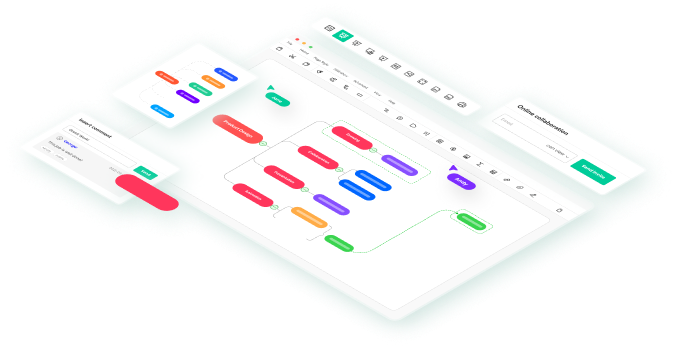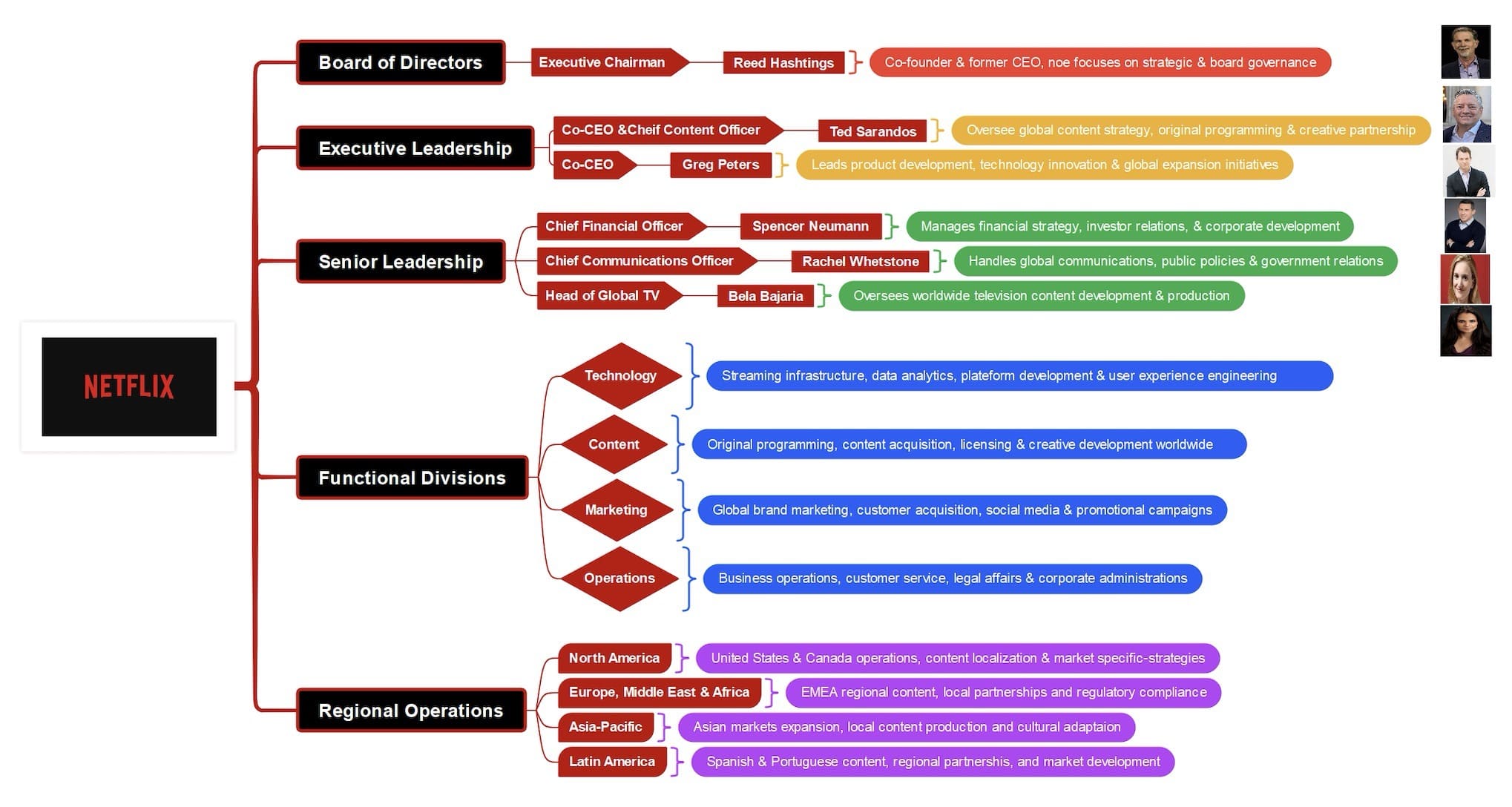Netflix began as a DVD rental company and transformed itself into a large streaming service. It has over 260 million subscribers now. The organizational chart demonstrates the way Netflix organizes its teams. They are currently busy developing content, technology development, and global expansion.
This guide simplifies and details the chart. You will see the key leaders and their work together as a team. They create trending shows and continue to stream smoothly without problems.
In this article
Netflix Organizational Chart
Netflix has been transformed into a large streaming company after starting to mail DVDs. This demonstrates that an intelligent method of operation can render an entertainment business successful.
Netflix has established a strong infrastructure to manage all that: the production of shows, the development of streaming technology, and advertising in numerous countries. Through an examination of the Netflix organizational structure, we can understand why the company remains ahead of its rivals, such as Disney+ and HBO Max, in the streaming industry.
Netflix Structure Type
Netflix mixes different organizational approaches; they've got specialized departments, regional offices, and cross-team projects all working together. They run specialized teams for different skills, but also have regional offices that serve local markets. The big decisions happen at headquarters, but regional teams have plenty of freedom to adapt to what’s trending.
Functional divisions serve as their backbone, delivering technical expertise and operational excellence. Geographic divisions ensure cultural relevance and regulatory compliance across different markets. When Netflix launches a new show or enters a new country, they pull people from different departments to work together temporarily. This setup helps them jump on opportunities when markets shift.
Netflix’s Number of Employees
Netflix employs approximately 12,000 people around the world. The number varies due to the fact that it relies on the number of shows that they produce and whether the company expands. Netflix does not employ a large number of office workers like the old media companies. It employs technology and collaborators to maintain low costs. The majority of the employees are in technology, content, or operations.
Netflix has a culture and strategy that is reflected in the organizational structure. It is also concerned with the recruitment and retention of the finest individuals. In the case of numerous projects, Netflix employs temporary contractors and freelancers. This allows them to hire employees as required without incurring additional expenses of hiring permanent employees.
Key Executives
The top managers at Netflix are not just goal setters, but they also manage the daily operations. These are the main jobs that you can see in the chart:
- Executive Chairman: Reed Hastings heads the board, is concerned with long-term objectives and key alliances.
- Co-CEO and Chief Content Officer: Ted Sarandos is in charge of global content strategy, original production, and collaborates with creators and studios across the world.
- Co-CEO: Greg Peters is concerned with technology, innovation, and global expansion. He operates in every country.
- Chief Financial Officer: Spencer Neumann handles cash, money, budgets, investor discussions, and transactions.
- Chief Communications Officer: Rachel Whetstone is in charge of PR, public policy, and government dealings.
- VP Global TV: Bela Bajari is in charge of global TV production.
The leaders collaborate, though each one of them possesses one area. Netflix has two CEOs to ensure that one is content-oriented and the other is technology-oriented, and international expansion. This maintains the two areas in good condition.
Adaptivity of the Structure
Netflix structured itself in such a way that it is flexible. Teams are dynamic to suit requirements and objectives, e.g., new projects or areas. This allows them to move personnel and funds without halting day-to-day operations.
In simple terms, cross-departmental collaboration is one of the fundamentals of Netflix.
As Netflix embarks on a large project, there is collaboration among tech people, content creators, marketers, and operations staff. They verify that a new show is technologically feasible, commercial, and entertaining to the audience. They are fast to test and adapt quickly to keep up with the competitive streaming world.
Netflix Organizational Divisions
- Functional divisions: Netflix organizes its employees into functional teams. These teams are central to the capabilities of the company.
- Technology division: Deals with streaming technology, data analytics, platform services, and user experience. They retain buffered shows.
- Content division: Handles original programming, content acquisition, licensing, and creative activities across the globe. It includes series, movies, documentaries, and foreign productions.
- Marketing department: Develops the brand, attracts customers, operates social media, and develops promos across the world. These strategies are tailored to local audiences by regional teams.
- Operations division: Business operations, customer services, legal services, and corporate administration. They maintain the smooth running.
Netflix’s Regional Operations
The international growth of Netflix requires local management, which is reflected in its organization:
- North America: Manages work in the US and Canada. They localize content and experiment with features.
- EMEA (Europe, Middle East, and Africa): Oversees European markets, regulations, and local content transactions. Dwelling on multilingual content and cultural adaptation.
- Asia-Pacific: Manages the expansion of Asian markets, local content generation, and cultural adaptation. They have to deal with numerous languages, country regulations, and the tastes of the audience.
- Latin America: Manages Spanish and Portuguese content, local joint ventures, and market building in Central and South America.
Every region makes decisions at the local level, but on the global plan developed by the leaders.
Why Does Netflix's Structure Work?
Netflix succeeds because it retains the same simple concept across all locations, but it also adapts to local preferences. Functional divisions ensure that the tech is good and all works well. Regional divisions assist in localizing it to local audiences. Whereas the top executives keep everyone aligned on strategy without micromanaging regional teams.
The following are the factors that make the structure effective:
- Every person is aware of the division of labor, from the top management down to each team. The teams collaborate between functions, and they make decisions together on content, technology, and marketing.
- Local offices are able to respond quickly to the needs of local customers.
- Experimenting in teams is not so cumbersome.
- Decisions get faster in a small structure with fewer rules.
- Technology does the bulk, and they have the capability of serving more than 200 million subscribers without much ado.
The two-CEO model of Netflix demonstrates the priorities of the company: to create great content and maintain technology at the edge. In this manner, the two regions receive the complete attention and all are geared towards achieving the same objectives.
How to Make Such an Org Chart?
Want to create your own Netflix-style org chart? First, you need to understand how their unique setup actually works. To make an organizational chart of your company, it is not hard. Concentrate on making it simple, correct, and clear. Here’s a step-by-step guide:
- Define the Purpose: Choose the reason why you are making the chart. Is it to talk within the company, training, presentations, or analysis? The purpose will guide you on the amount of detail to use.
- Collect Information: Get the right data concerning the structure of your company, who is in charge, what the departments are, who is in each group, and who reports to whom. Ensure names, titles, and responsibilities are up-to-date.
- Identify Key Levels: Draw a structure: Board of Directors (assuming that you have one), top executives, senior managers, major departments, and team leaders. There must be a clear reporting relationship between each level.
- Choose a Chart Style: Select a layout that suits you. Top-down hierarchy is the most widespread, but a matrix, flat, or combination of styles may be used based on the structure of your company.
- Visualize with Tools: Make a clean and professional chart using tools such as EdrawMind, Lucidchart, Visio, or PowerPoint. Begin with a blank canvas or template.
- Add Departments and Roles: Make all the major departments (such as Technology, Marketing, Operations), branches, and include smaller teams. Include regional or project groups as necessary.
- Review and Update: Review the chart and make sure it is accurate and clear. It must be able to be grasped at a glance. Revise it regularly when teams develop or evolve.
These steps will allow you to build an org chart that not only makes your company structure visible but also allows teams to remain on track and makes responsibilities transparent to all.
Step-by-Step Guide to Make an Organizational Chart
Once you have gathered data and selected a design, it is time to create the chart. To create a chart similar to the one of Netflix, I have used Wondershare EdrawMind, which is a free org chart maker.
Step1 Begin with a New Canvas
- Use a top-down layout to show how decisions flow from executives down to regional teams.
- Insert logo or name in the Main Idea box. From there, all the branches will be formed.

Step2 Add Board of Directors
- To add the first branch, you need to click on the subtopic from the toolbar.
- Name it Board of Directors- the highest rank of leadership.
- You can add further subtopics beside it to specify board members or committees.

Step3 Include Executive Leadership
- Add another subtopic below the Board of Directors which is Executive Leadership.
- Add boxes with executive positions Co-CEO, Chief Content Officer, etc.
- Choose a summary box from the toolbar to mention their role or for their job description.
- You can also add images (optional) of the team members through the option Floating topic next to each summary box from the toolbar.

Step4 Add Senior Leadership
- Add a third subtopic, which is Senior Leadership, from the main topic
- Further, create other subtopics of the senior executives section from the toolbar.
- Keep adding subtopics side-by-side if you want to branch out more details of the roles.
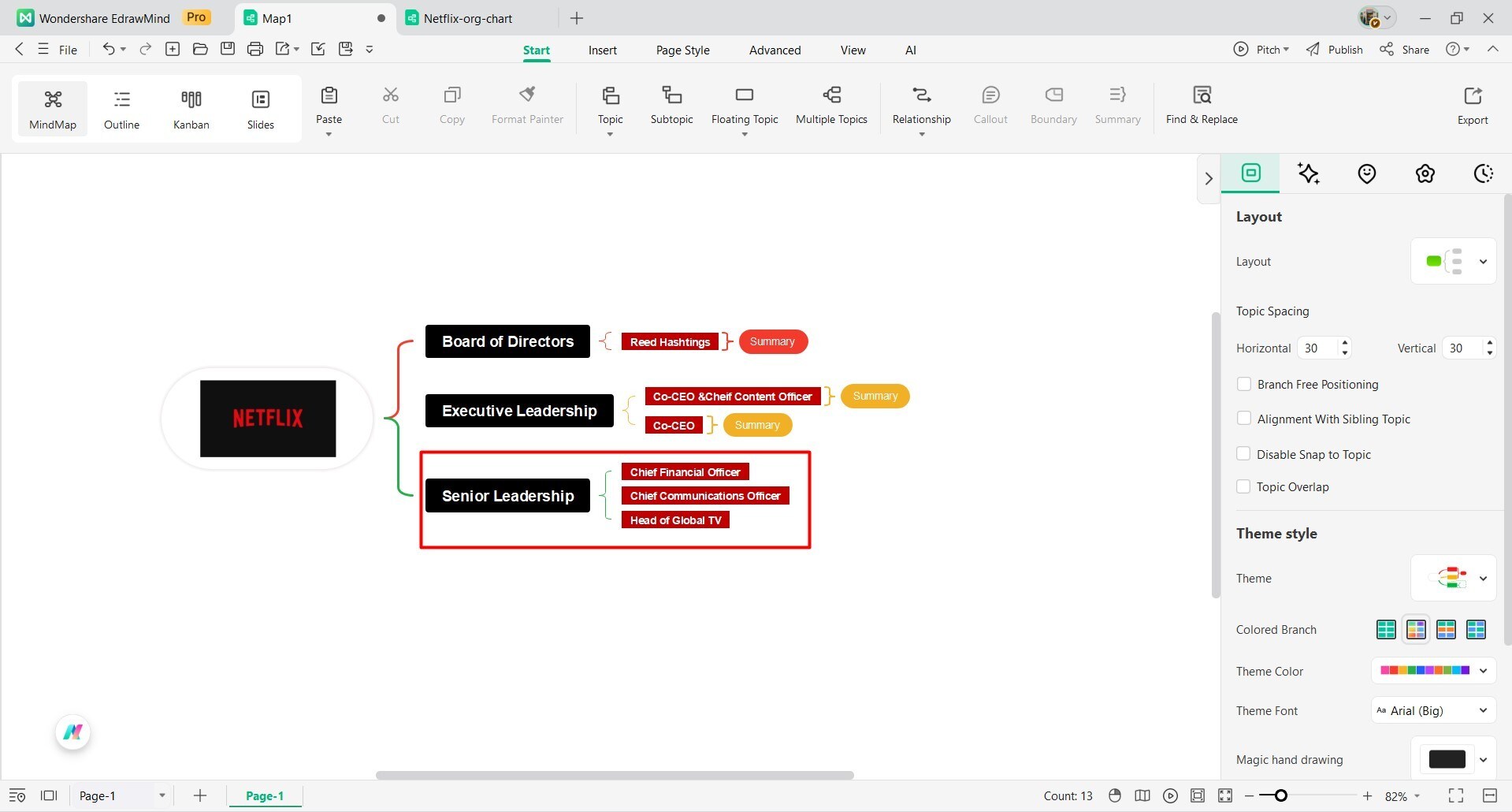
Step5 Include Functional Divisions.
- In case your company has different operational departments, add a subtopic named Functional Divisions.
- Add subtopics under it of each major department with a different box style to make them visible.
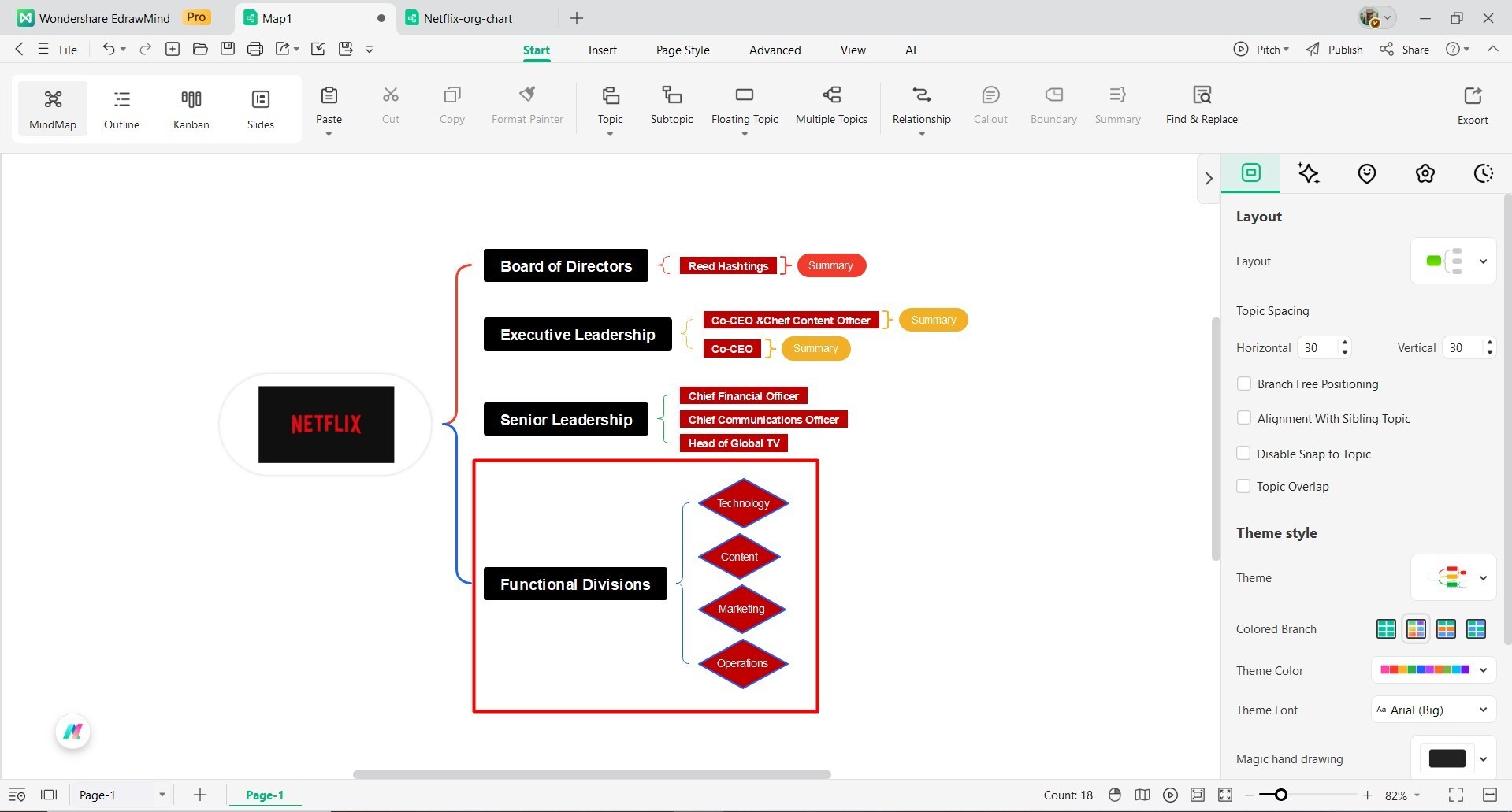
Step6 Add Regional Operations
- Another subtopic to add is the Regional Operations, in case your company operates in multiple locations.
- Include subtopics, which are named by each region, but with a different box shape to distinguish between regions and functional divisions.

Step7 Review & download
- Thoroughly check all the connected tiers and their roles.
- Then save or export in PDF, PNG, or PowerPoint.
- You can also share the org chart with your teammates by sharing a link.
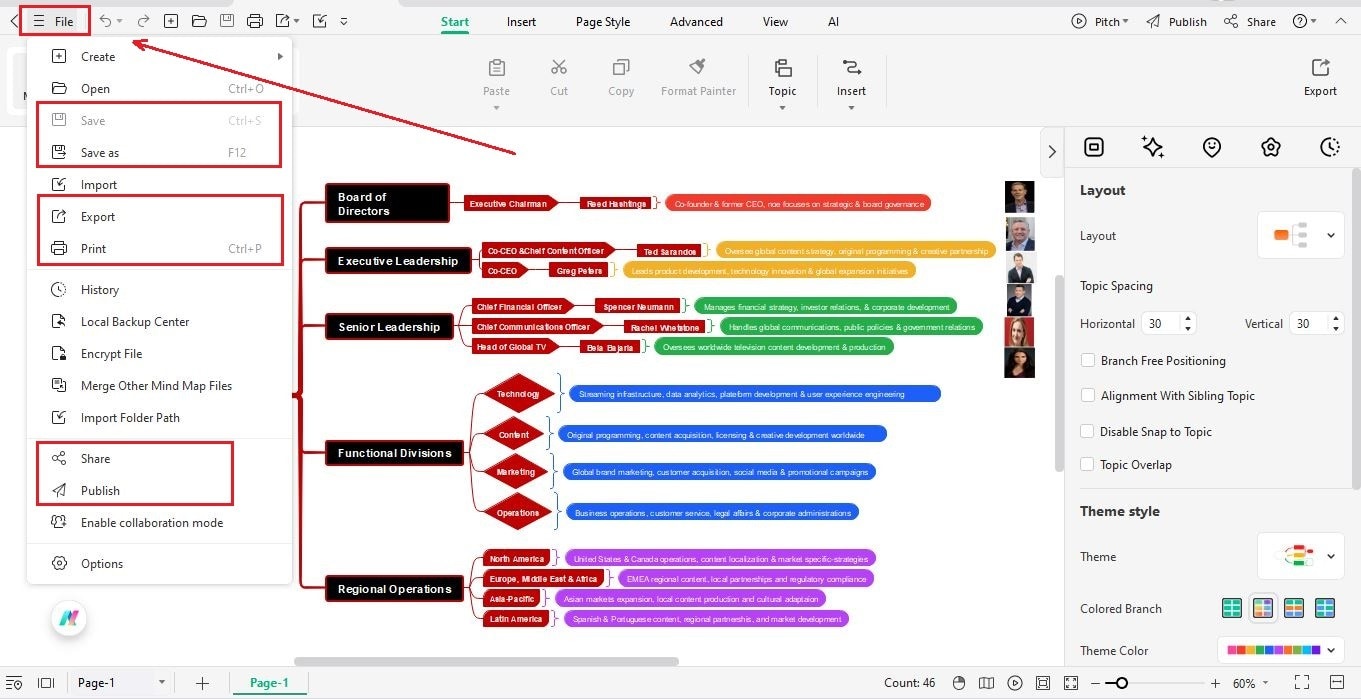
Conclusion
By following these steps, you can create an organizational chart that clearly shows reporting relationships and departmental structures. Whether you use EdrawMind, Lucidchart, or Visio, the goal is to build a chart that’s neat, accurate, and easy to update as your company grows.



